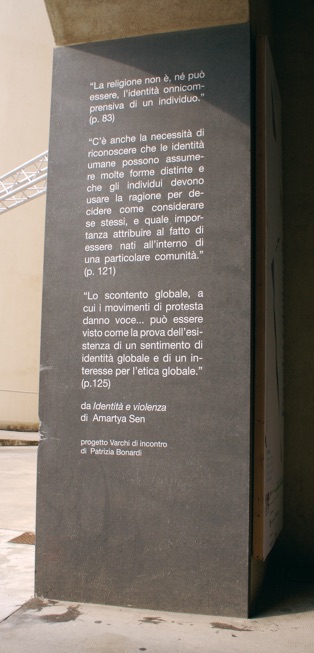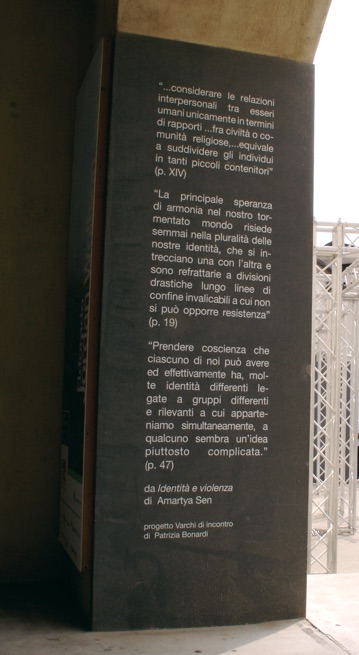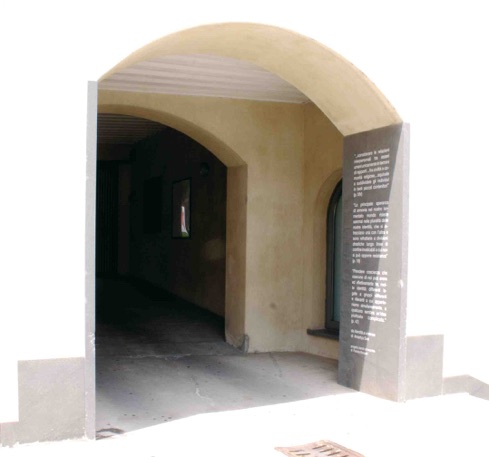Patrizia Bonardi

2007
Installation at GAMeC (adhesive letters on stone)
installazione alla GAMeC (lettere adesive su pietra)
Open to meet - at GAMeC
Amartya Sen, the Indian economist, Nobel prize winner in 1998, has boosted this work with his “Identity and
violence”.
The living modules, the cubic cells of the palace in liquid collapses, get here their own symbolic autonomy,
becoming at the same time more rational, as Sen’s
analysis was.
It’s as if I had ideally rebuilt the living spaces that had been destroyed in the palace and imagined that each of them had a denied, miniaturized identity.
I linked these modules to some specific sentences
referred not only to Sen’s ideas but dug up in my deep personal experience as well.
The initial words of each sentence are “not only a...”, being a way to open the mind towards the exact contrary of labelling, of disparaging.
The relation between the elements recalls crosswords.
The fact of communicating something very dramatic through the idea of a game enriches the work: game is strategy, it’s the capacity to see things in a new way. it’s the humility to feel that we are player in the same game.
The sentences intercept the wax modules and a passage opens when they meet.
Ideally, a hypertrophy of thoughts and attentions towards these modules would lead to their non-existence, and the useless disagreements between men would melt.
I had the opportunity to put the quotations taken from “Identity and violence” on the surfaces made of dark
stone covering the foundations of the courtyard entry arch at GAMeC, as if they were Beuys’ blackboards where the words of a big teacher can be written and our collective soul can rest. (tr. i.r.)


Amartya Sen, l’economista indiano vincitore del
premio nobel nel 1998, ha dato impulso a questo lavoro con il suo “identità e violenza”.
I moduli abitativi, le celle cubiche del palazzo di crolli liquidi, hanno preso una loro autonomia simbolica, divenendo contemporaneamente più razionali, come lo era l’analisi di Sen. Idealmente è come se avessi ricostruito i vani abitativi distrutti del palazzo e immaginato che ciascuno fosse un’identità negata, miniaturizzata. Ho legato questi moduli a delle frasi che si riferissero non solo all’idee di Sen, ma che scavassero in una mia profonda esperienza personale.
Le parole iniziali di ogni frase sono “non solo uno ...”, un modo per aprire la mente verso l’esatto contrario dell’etichettare, dello sminuire.
Il rapporto fra gli elementi ricorda il cruciverba.
Il voler dire qualcosa di molto drammatico tramite l’idea di un gioco, arricchisce l’opera, vista l’ampiezza
dell’argomento: il gioco è strategia, è capacità di vedere le cose in un modo nuovo, è l’umiltà di sentirsi giocatori di una medesima partita.
Le frasi intercettano i moduli di cera e dal loro incontro nasce il varco.
Idealmente se ci fosse un’ipertrofia di pensieri, di attenzione verso questi moduli, loro non
esisterebbero più, tutta la vana suddivisione che vede contrapporre gli uomini si scioglierebbe liquefatta nella sua inesistenza.
In GAMeC ho avuto l’opportunità di mettere sulle superfici in pietra scura che rivestono le basi dell’arco di ingresso al cortile, le citazioni da “Identità e violenza”, come fossero le lavagne di Beuys su cui tracciare parole di un grande maestro, come basi su cui poggiare il nostro
spirito collettivo.



